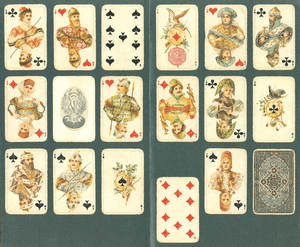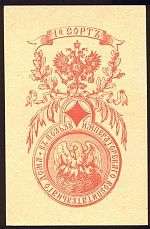Russian playing cards
_Russian_style_1911_original.jpg)
Russian playing cards are cards that used predominantly in Russia and in the former Soviet Union. Unlike the internationally known standard French 52-card deck, most Russian card games employ either the 36 card (games such as Durak) or the 32 card (particularly Preferans) decks.
History
Playing cards were first introduced into Russia at the beginning of the 17th century from Western and Central Europe (supposedly from Germany and Poland). But they were soon banned, Sobornoye Ulozheniye of 1649 mentioned card games as one of the "thief's crimes" punished by lashing, however, since Peter the Great the ban was usually ignored. In spite of many attempts by the Russian government to restrict card games, many Russians, especially the Russian nobility, played cards in a significant scale during the 18th century.
Before the 19th century practically all playing cards were imported from Western and Central Europe, and since 1765 all imported cards had to be stamped and the high import duty had to be paid (that was supposed to limit card gaming). However, in 1819 the restrictions were lifted, but at the same time the import of playing cards was also forbidden and the state monopoly was created. The production of own Russian playing cards started in the Imperial Card Factory of the Imperial Paper Mill in Aleksandrovo (now a part of Saint-Petersburg).
Design
_designed_by_Adolf_Charlemagne.svg.png)
The design of the Russian card decks were derived and influenced by the German card decks as well as the French card decks. Russian cards in the market were divided into three or four categories, depending on the quality of paper and printing: from cheapest decks for laymen through medium quality decks for the Russian middle class to high class decks for the imperial court and the higher nobility. The middle category was covered by talcum powder, its cards were smooth and easy to shuffle, hence the term satin cards (Russian: атласные карты). In 1862 the renown Russian painter Adolf Charlemagne (Russian: Адольф Шарлемань) created a new unified design. Very soon his design became the most widespread and recognizable and it is still widely produced and used in Russia. Apart from that nearly fifty card designs were devised by various Russian artists during the 18th–20the centuries.
"Russian style"

The end of the 19th and the beginning of 20th knew the rising interest to the old pre-Petrine Russian traditions (see also Russian Revival architecture), this fashion was even more intensified due to the 300th anniversary of the house of Romanovs in 1913. As a result, in 1911 the particular card design in the "Russian style" (Russian: колода «Русский стиль») was created. The costumes of the face cards imitated the historical 17th century Russian costumes of the famous 1903 Ball in the Winter Palace.
Deck
Due to the German influence the Russian standard deck contains only 36 cards from 6 to the ace. For some games, particularly Preferans, the 6s are not used, resulting in the 32 card deck. Nevertheless, the 52 card decks may also occur.

The design of the pip (numerical) cards as well as the suits (♣, ♦, ♥, ♠) resemble those of French playing cards. The design of the face cards is either that of Adolf Charlemagne or in the "Russian style". The design of the aces are variable, historically the ace of diamonds showed the coat of arms of the Russian Empire. The face cards and the aces are marked by the Russian letters that correspond to the Russian rank names:
- T (туз, tuz from German: Daus "deuce" via Polish: tuz) for Ace
- К (король, korol', "king") for King
- Д (дама, dama from German: Dame) for Queen
- В (валет, valet from French: valet) for Jack
The names for the pip cards are derived from Russian numerals: шестёрка, семёрка, восьмёрка, девятка, десятка (shestyorka, semyorka, vos'myorka, devyatka, desyatka) for 6, 7, 8, 9, 10 respectively.
In Russian culture
The popularity of card games in Russia was portrayed by some famous Russian writers, particularly Alexandre Pushkin who wrote The Queen of Spades.
Because the 6 is the lowest card of the Russian deck, Russian slang uses the derogatory word shestyorka meaning "underling, lackey".
References
| Wikimedia Commons has media related to Atlasnye playing cards. |
- (Russian) Комиссаренко С. С. (2003). "Игра в карты как культурная традиция русского общества XVIII-XIX вв.". Культурные традиции русского общества. pp. 88–106.
- (Russian) Григоренко Е. Н. "Атласные карты академика Шарлеманя".
- (Russian) Григоренко Е. Н. (2013). Русские игральные карты: история и стиль. Историко-культурный очерк. ISBN 978-5-9904149-1-4.
External links
- Playing cards from Russia. The World of Playing Cards.
